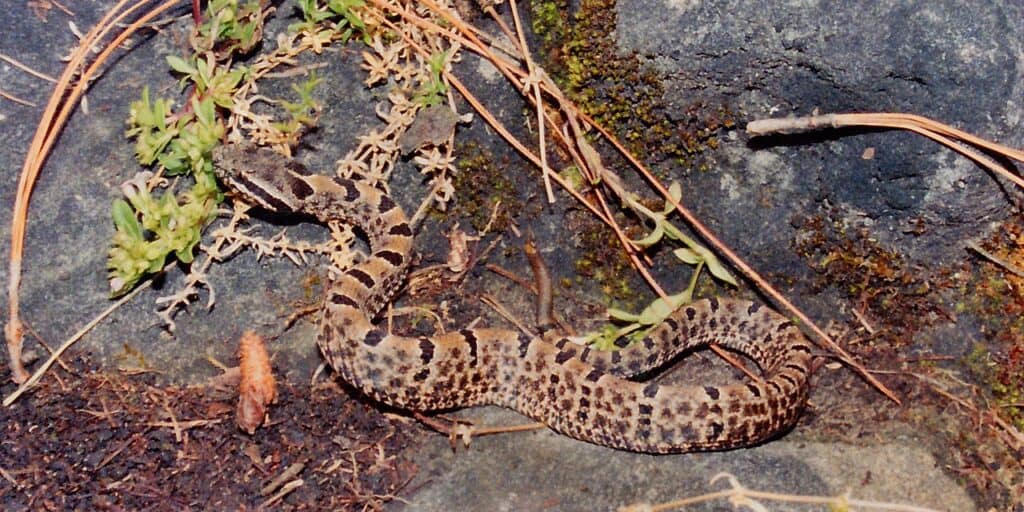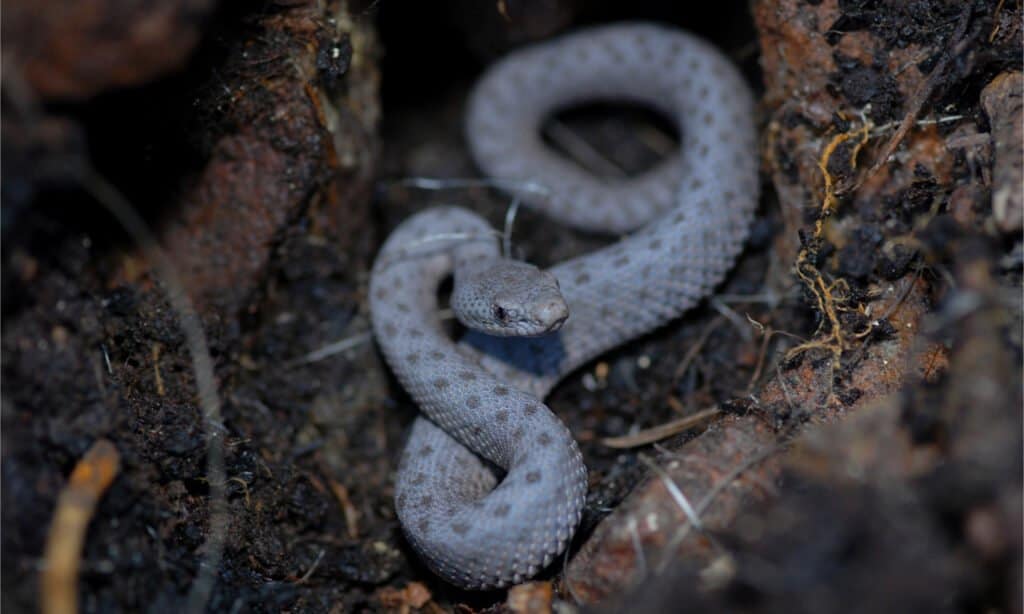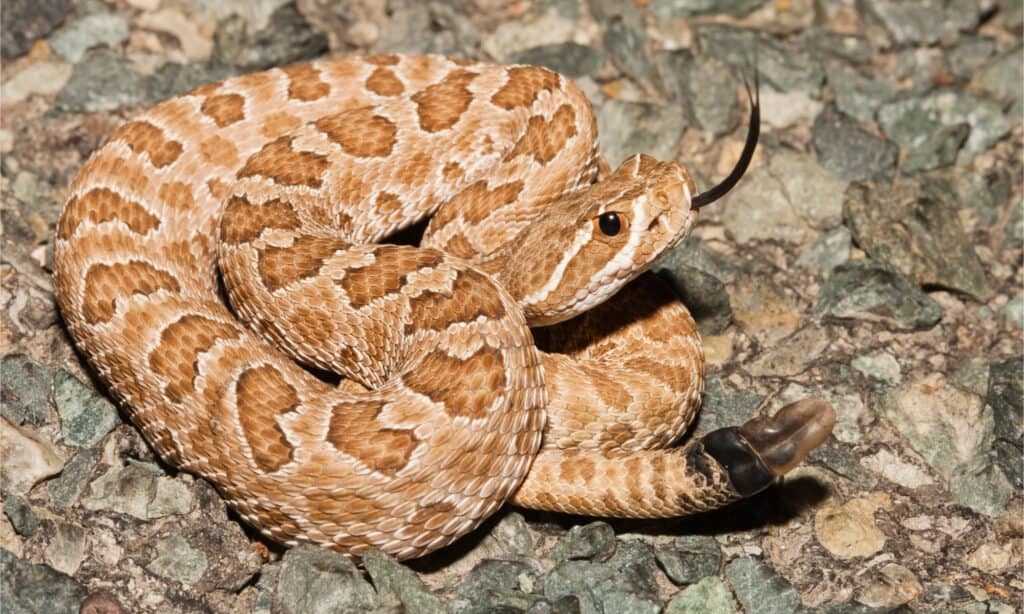For most of us, the thought of a rattlesnake, or the sound of its famous rattle, is enough to strike fear into our minds. But, in truth, rattlesnakes are much more interested in creatures like mice, rats, and rabbits than they are in humans. They can be found through the United States, southern Canada, and as far south as Argentina. We all know that adult rattlesnakes come equipped with rattles, but do baby rattlesnakes have rattles too?
If you’re planning on going on a hike anywhere in North America anytime soon, then you might want to know a little bit about rattlesnakes, particularly about baby rattlesnakes. Here, we’ll learn more about a rattlesnake’s life, how long it lives, how many babies are born at once, and of course, whether or not baby rattlesnakes have rattles. Then, we’ll learn how to avoid baby rattlesnakes and what to do if you find one. Finally, we’ll explore why rattlesnakes are essential parts of the ecosystem and should be left alone if encountered.
The Rattlesnake Lifecycle

Rattlesnakes are ovoviviparous and some species live up to 25 years in captivity.
©Rusty Dodson/Shutterstock.com
Rattlesnakes are ovoviviparous, meaning that females develop eggs, but they never lay them. Instead, the eggs stay inside the female rattlesnake’s body, surrounded by a thin membrane. Then, the female gives birth to live baby snakes.
Rattlesnakes generally live around ten years in the wild, though captive specimens have lived up to 25 years. Each year, the snake goes through periods of activity and rest. Rattlesnakes feed, grow, molt, and mate in the spring, summer, and fall months. But, when winter sets in and during the hottest parts of the summer, their metabolisms slow down, and they find a nice den to rest in until the weather better suits them.
Are Baby Rattlesnakes Born with Rattles?

Baby rattlesnakes are not as dangerous as adults. They have less venom because they’re smaller!
©William L. Farr / CC BY-SA 4.0 – License
When baby rattlesnakes first emerge from their mother, they have a single, button-like link on the tip of their tail. Baby rattlesnakes aren’t born with rattles, but they are born with the beginning of what will eventually become a rattle. The button on the end of the tail is the first segment of the rattle.
Baby rattlesnakes shed their skin for the first time within one week of life. After that first molt, they’re left with a second rattle segment attached to the first. However, this still isn’t enough to create adults’ distinctive ‘rattle’ sound. Baby rattlesnakes can’t rattle until after they’ve molted at least twice.
Every time the baby rattlesnake molts, it gains a rattle segment for the rest of its life. Rattlesnakes may molt several times a year. However, you can’t tell a rattlesnake’s age by counting how many rattles it has, as the rattle frequently breaks off.
How Do You Tell if a Baby Snake is a Rattlesnake?

Baby rattlesnakes, like adults, have distinct triangular heads.
©Rusty Dodson/Shutterstock.com
You know that baby rattlesnakes don’t have rattles, so how do you tell if the baby snake you’re looking at is a rattlesnake or some other, less dangerous species? Well, the first thing to remember is not to approach the snake. No matter what kind of snake it is, you should treat it with caution and respect. But, if you’re curious, take a look at the pattern and at the shape of the head.
Rattlesnakes have a distinct diamondback pattern to their scales, a little bit like a python. Their base scales are generally sand-colored, with darker brown markings. If the pattern fits, then take a look at the head. Rattlesnakes, no matter the age, have distinct, triangular heads.
Where Are Baby Rattlesnakes Found?

Baby rattlesnakes can be found hiding under rocks or bushes.
©Nathan A Shepard/Shutterstock.com
Rattlesnakes can be found in almost all parts of the continental United States. They can also be found in Central America, South America, and Mexico.
Baby rattlesnakes are most commonly seen in the late spring and early summer. Females generally give birth after their winter brumation (similar to hibernation), when the weather starts to warm up. Baby rattlesnakes have a high mortality rate, meaning many of them are born, but not nearly as many make it to adulthood, so they tend to stay hidden. They’re much more likely to be found hiding under bushes or rocks, though they do come out to sun themselves and hunt for small prey like mice and insects.
What to Do if You Find a Baby Rattlesnake
Let’s say you’re out hiking on a beautiful, early summer day. You come around a corner, and right there in the trail is a one-foot-long baby rattlesnake. It may not have a rattle, but it can still bite you, which would require a trip to the hospital for antivenom. To avoid a nasty bite, follow these steps.
First, don’t make any sudden movements. Stay calm, and don’t approach the baby rattlesnake. Remember, it’s a wild animal and should be treated with respect. Slowly move away from the snake. If it’s in the trail, it will probably move to a more protected place, but be sure to give it a wide berth.
Why are Rattlesnakes Important?
Despite their bad reputation, rattlesnakes are extremely important for the environment. Like wolves and coyotes, rattlesnakes have long been vilified and killed on sight by fearful people. But, rattlesnakes pose very little threat to people and livestock. They would rather hide from humans, cows, horses, and dogs.
When too many rattlesnakes are killed, the local rodent populations explode. If there are too many rodents, they overeat all the greens, like grasses and forbs, in the surrounding area. When that happens, other creatures that rely on that food, like deer or antelope, starve. So, killing a rattlesnake might not seem like a big deal, but it can have vast repercussions throughout the ecosystem. To maintain a healthy natural world, it’s important to let rattlesnakes be, whether they’re babies with no rattles or adults equipped with rattles.
The photo featured at the top of this post is © Sundry Photography/Shutterstock.com
Discover the "Monster" Snake 5X Bigger than an Anaconda
Every day A-Z Animals sends out some of the most incredible facts in the world from our free newsletter. Want to discover the 10 most beautiful snakes in the world, a "snake island" where you're never more than 3 feet from danger, or a "monster" snake 5X larger than an anaconda? Then sign up right now and you'll start receiving our daily newsletter absolutely free.
Thank you for reading! Have some feedback for us? Contact the AZ Animals editorial team.






